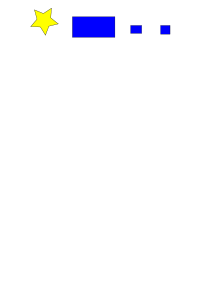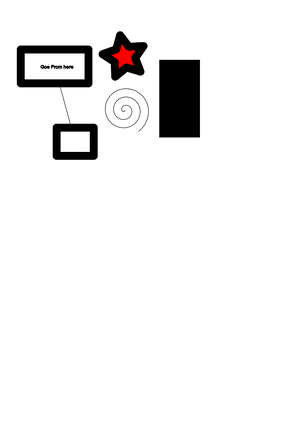Style Guide
This page is the manual of style for the Escher wiki.
Language
- The word "figure" is preferred for plane sets, drawings, images when discussing symmetries.
- Use of "we" is acceptable but try to avoid as much as possible.
- Use of "you" is avoided.
Mathematical Definitions
When defining a mathematical concept, use the Template:define template around the words being defined. At the moment, this simply puts the words into bold face. Later, this will be used for indexing.
Definitions can be made as part of the flow of the text:
If points on an object are equally positioned about a point, then we say the object has {{define|rotational symmetry}}.
which gives:
If points on an object are equally positioned about a point, then we say the object has rotational symmetry.
Or using the mediawiki define syntax:
;Similar triangles:Two triangles are {{define|similar}} if they have the same angle measures.
which gives:
- Similar triangles
- Two triangles are similar if they have the same angle measures.
Boxed Statements or Formulas
To emphasize an very important statement or formula, use the Template:Boxed template around the text. The text
{{boxed|A very important formula}}
results in
A very important formula
Explorations
An exploration called "Really Fun" should be on a page named "Really Fun Exploration". Every exploration should include Template:Exploration at the top. Every exploration should also include Template:Time and Template:Objective at the top to list the learning objective and the expected time for completion. At the bottom, include Template:Handin to explicitly state what should be handed in by the student.
An example of a correctly formatted Exploration:
{{Exploration}}
{{Time|20}}
{{Objective|Waste 20 Minutes.}}
Step 1: Use Inkscape to draw a lobster.
{{Handin|A printout of your lobster picture}}
Using just {{Handin}} with no argument gives:
Handin: A sheet with answers to all questions.
Referring to Escher Artworks
Escher Artworks are each given their own page. Refer to the work by linking to the page - no other information (year, where to find it) is necessary because that's all on the artwork's page. To refer to Castrovalva, use [[Castrovalva]].
The Regular Division of the Plane Drawings should be referred to with Template:sketch, using the syntax {{sketch|number|name}}. For example, {{sketch|3|weightlifters}} gives Sketch #3 (weightlifters).
Unnamed minor works won't get their own page, so refer to them with citation information (see Citations to Escher Books, below) or include a scanned picture.
The individual artwork pages are created with Template:Escher Artwork. See the discussion page for the template for details on parameters: Template_talk:Escher_Artwork
One of the goals of isolating Escher's artwork is to make it easier to control access rights in the future. Possibly, only authorized readers could see the online images.
Citations to Escher Books
When referring to Visions of Symmetry, use {{VOS}} (the Template:VOS).
When referring to Magic of M.C. Escher, use {{Magic}} (the Template:Magic).
Because these books are intended to be used as companions to this wiki, it is too much to put their full titles and citation information in running text. Instead, these templates produce a short reference in the text. Some day they will link to complete bibliographic information.
When referring to M.C. Escher: His Life and Complete Graphic Work, use {{Bool}} (the Template:Bool). Sadly, some pages use Template:LWE for this. Use the Bool version instead.
Instructor Resources
Instructor information can be located in three places:
- As individual pages targeted towards instructors, and presumably linked to by the Instructor Resources page.
- As individual pages protected from public view. These pages are only readable by logged in users, which at this time can only be instructors. These pages should be placed in the 'Instructor' namespace, by prefixing their names as in Instructor:Rosette Exercises Solutions.
- On the discussion pages associated with content/exploration/homework/etc. Use {{Instructor Notes}} (the Template:Instructor Notes) for this. Appropriate comments for discussion pages include "I often assign problem 6 because I use the results later in my course" or "watch out for question 4, it's a bit of a trick question". It's probably not appropriate to put complete answers up there because the page is accessible to students.
Symmetry Groups
References to symmetry groups should use Template:group to get, for example, pmm2.
Other useful templates
To link to a useful printable resource, use Template:printable which takes one argument. For example, {{printable|The seven frieze groups: [[Image:frieze-printable.pdf]].}} produces
To alert students to a potential pitfall, use Template:Alert which takes one argument.
To force text to fall below pictures (as opposed to wrapping around), use Template:Clear. This section uses it, as an example.
To force a page break in the printable form of a page, use Template:Pagebreak.
External Links
Links to Wikipedia should use the special syntax [[wikipedia:Lithography]] which gives the link wikipedia:Lithography.
Links to Wikimedia Commons can use [[commons:Main Page]].
Footnotes
Footnotes use the <ref>, </ref>, and <references/> tags described at [1]. For an example, see Introduction_to_Symmetry#_ref-0.
Math
Examples:
Images
Style
Use 2 point thickness for most lines, outlines, diagrams. Use 1 point thickness for less important lines.
Figures are usually black, with red for marking symmetry or other annotation. Next, the light blue and light orange are used for color details.
Technical
Don't give images names containing underscore '_'. More or less standard for this wiki is to use hyphens instead of spaces for uploaded file names.
Bitmap images should use .jpg or .png.
Illustrations should use the 'svg' format. SVG is scalable vector graphics, so it will look good at any size. It's got small file sizes and is easily editable once stored on the wiki. Inkscape is a free program that can create and edit SVG images.
Currently, text inside of svg images is hit-and-miss. Sometimes it works, sometimes not. If possible, avoid text inside of svg illustrations, and use captions instead. If you really want some text, it is advisible to convert it to a path. Inkscape can do this.
I've also had trouble with arrowheads in SVG files.
Here's an svg image which is supposed to have text in it:


Here's another one (thumbnailed), on the right. Notice the large white area below the goods. That's because I didn't resize the page to fit the contents (while using Inkscape). You can do this by selecting all, then Document Properties (on the File menu) then Fit page to selection.





